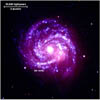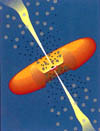News Archive
1996 |
1997 |
1998 |
1999 |
2000 |
2001 |
2002 |
2003
2004 | 2005 | 2006 | 2007 | 2008 | 2009 | 2010 | 2011
2012 | 2013 | 2014 | 2015
2004 | 2005 | 2006 | 2007 | 2008 | 2009 | 2010 | 2011
2012 | 2013 | 2014 | 2015
![]()
Welcome to our archive of past news articles.
You will find previous articles listed below
from most the recent back to our first articles in 1996.
2005
 |
Is A Supernova By Any Other Name Still As Sweet? [21 December 2005] - Scientists using NASA's Chandra X-ray Observatory have witnessed a cosmic rite of passage, the transition from a supernova to a supernova remnant, a process that has been poorly defined and never seen in much detail until now. |
 |
Three Satellites Discover One Elusive Star [15 November 2005] - An international team of scientists has uncovered a rare type of neutron star so elusive that it took three satellites to identify it. The discovery highlights the complementary nature of European and U.S. satellites to reveal new insights about star birth and death in our galaxy. |
 |
In a Flash NASA Helps Solve 35-year-old Cosmic Mystery [07 October 2005] - Scientists have solved a 35-year-old mystery of the origin of powerful, split-second flashes of light called short gamma-ray bursts. These flashes, brighter than a billion suns yet lasting only a few milliseconds, have been simply too fast to catch... until now. |
 |
Most Distant Explosion Detected, Smashes Previous Record [30 September 2005] - Scientists using NASA's Swift satellite and several ground-based telescopes have detected the most distant explosion yet, a gamma-ray burst from the edge of the visible universe. |
 |
NASA'S Swift Satellite Provides New Insight into Black Hole Formation [22 August 05] - Baby black holes apparently come into the world kicking and screaming, not unlike humans. Scientists using NASA's Swift satellite say they have found newborn black holes, just seconds old, in a confused state of existence. The holes are consuming material falling into them while somehow propelling other material away at great speeds. |
 |
Orbiting Stars Flooding Space With Exotic Gravitational Waves [27 July 2005] - A scientist using NASA's Chandra X-ray Observatory has found that two white dwarf stars orbiting each other in a death grip, destined to merge spectacularly, may be flooding space right now with gravitational waves. These waves are ripples in space-time predicted by Einstein but never detected directly. |
 |
Japan Launches World-Class Space Observatory With NASA Instruments [11 July 2005] - A pioneering X-ray detector developed at NASA Goddard Space Flight Center in Greenbelt, Md., successfully launched aboard a major new Japanese space observatory on Sunday, July 10, at 12:30 p.m. local time (July 9 at 11:30 p.m. EDT) from Uchinoura Space Center in southern Japan. |
 |
NASA Scientists Catch Unique Gamma-Ray Burst [24 May 2005] - After 30 years, they finally caught one. Using the Swift satellite, scientists for the first time detected and pinned down the location of a so-called "short" gamma-ray burst, one lasting only 50 milliseconds. |
 |
Newly Seen Force In Star Formation May Help Gravity [26 April 2005] - Like viewing a baby's first ultrasound, scientists have pierced through a dusty stellar nursery to capture the earliest and most detailed view of a collapsing gas cloud turning into a star. |
 |
New Black Hole Census Reveals Major Undercount and Great Extinction [17 March 2005] - Scientists using NASA's Chandra X-ray Observatory and other world-class facilities have discovered that the total number of massive black holes in the Universe is 75 percent more than what was previously estimated. This new black hole census, a compilation of five years of observations, dramatically alters theories of how galaxies form and evolve. |
 |
Cosmic Explosion Among the Brightest in Recorded History [25 February 2005] - Scientists have detected a flash of light from across the Galaxy so powerful that it bounced off the Moon and lit up the Earth's upper atmosphere. The flash was brighter than anything ever detected from beyond our Solar System and lasted over a tenth of a second. NASA and European satellites and many radio telescopes detected the flash and its aftermath on December 27, 2004. |
 |
A Race Around a Black Hole [20 January 2005] - So you think rockets are fast? Scientists have spotted something going much faster. Like state troopers on a highway, these scientists used a "speed gun" to clock clumps of hot iron gas whipping around a black hole at 20,000 miles per second - over 10 percent of light speed. At that speed, you could get to the moon in about 10 seconds. |
1996 |
1997 |
1998 |
1999 |
2000 |
2001 |
2002 |
2003
2004 | 2005 | 2006 | 2007 | 2008 | 2009 | 2010 | 2011
2012 | 2013 | 2014 | 2015
2004 | 2005 | 2006 | 2007 | 2008 | 2009 | 2010 | 2011
2012 | 2013 | 2014 | 2015
Take Me to the News Page

